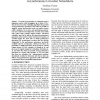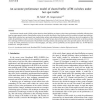107 search results - page 7 / 22 » Smooth switching problem in buffered crossbar switches |
SIGCOMM
1995
ACM
15 years 3 months ago
1995
ACM
ABSTRACT: Switch chips are building blocks for computer and communication systems. Switches need internal buffering, because of output contention; shared buffering is known to perf...
103
click to vote
TON
2010
14 years 6 months ago
2010
Abstract-- The problem of providing quality of service guarantees for multicast traffic over crossbar switches has received a limited attention, despite the popularity of its count...
INFOCOM
2006
IEEE
15 years 5 months ago
2006
IEEE
– Crossbar-based switches are commonly used to implement routers with throughputs up to about 1 Tb/s. The advent of crossbar scheduling algorithms that provide strong performance...
ICC
2009
IEEE
15 years 6 months ago
2009
IEEE
—To avoid head of line blocking in switches, Virtual Output Queues (VOQs) are commonly used. However, the number of VOQs grows quadratically with the number of ports, making this...
107
click to vote
COMCOM
1999
14 years 11 months ago
1999
Asynchronous transfer mode (ATM) switches based on shared buffering are known to have better performance and buffer utilization than input or output queued switches. Shared buffer...


